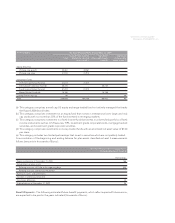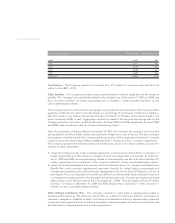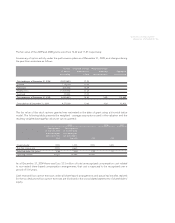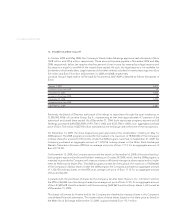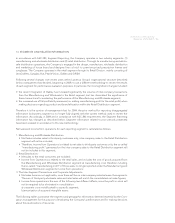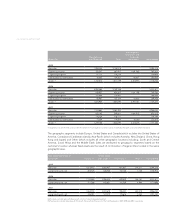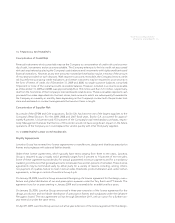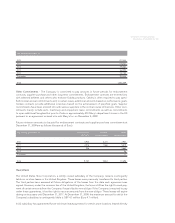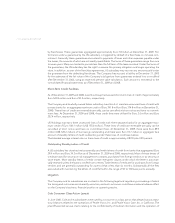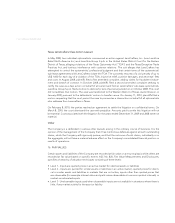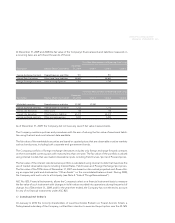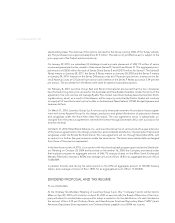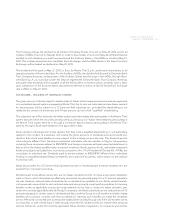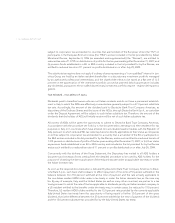LensCrafters 2009 Annual Report Download - page 99
Download and view the complete annual report
Please find page 99 of the 2009 LensCrafters annual report below. You can navigate through the pages in the report by either clicking on the pages listed below, or by using the keyword search tool below to find specific information within the annual report. NOTES TO CONSOLIDATED
FINANCIAL STATEMENTS | 97 <
14. FINANCIAL INSTRUMENTS
Concentration of Credit Risk
Financial instruments which potentially expose the Company to concentration of credit risk consist prima-
rily of cash, investments and accounts receivable. The Company attempts to limit its credit risk associated
with cash equivalents by placing the Company’s cash balances and investments with highly rated banks and
fi nancial institutions. However, at any time amounts invested at these banks may be in excess of the amount
of insurance provided on such deposits. With respect to accounts receivable, the Company limits its credit
risk by performing ongoing credit evaluations and certain customers may be required to post security in
the form of letters of credit. As of December 31, 2009 and 2008, no single customer balances comprised
10 percent or more of the overall accounts receivable balance. However, included in accounts receivable
as of December 31, 2009 and 2008, was approximately Euro 13.0 million and Euro 12.3 million, respectively,
due from the host stores of the Company's licensed brands retail division. These receivables represent cash
proceeds from sales deposited into the host stores, bank accounts, which are subsequently forwarded to
the Company on a weekly or monthly basis depending on the Company’s contract with the particular host
store and are based on contract arrangements that are short term in length.
Concentration of Supplier Risk
As a result of the OPSM and Cole acquisitions, Essilor S.A. has become one of the largest suppliers to the
Company’s Retail Division. For the 2009, 2008 and 2007 fi scal years, Essilor S.A. accounted for approxi-
mately 9 percent, 12.0 percent and 15.0 percent of the Company’s total merchandise purchases, respec-
tively. Management believes that the loss of this vendor would not have a signifi cant impact on the future
operations of the Company as it could replace this vendor quickly with other third-party suppliers.
15. COMMITMENTS AND CONTINGENCIES
Royalty Agreements
Luxottica Group has entered into license agreements to manufacture, design and distribute prescription
frames and sunglasses with selected fashion brands.
Under these license agreements, which typically have terms ranging from three to ten years, Luxottica
Group is required to pay a royalty which generally ranges from 5 percent to 14 percent of the net sales.
Some of these agreements provide also for annual guaranteed minimum payments and for a mandatory
marketing contribution (that generally amounts to between fi ve and ten percent of net sales). These license
agreements may be terminated early by either party for a variety of reasons including, among others,
non-payment of royalties, failure to meet minimum sales thresholds, product alteration and, under certain
agreements, a change in control of Luxottica Group S.p.A.
On January 28, 2009, Luxottica Group announced the signing of a license agreement for the design, manu-
facture and global distribution of sun and prescription eyewear under the Tory Burch and TT brands. The
agreement runs for six years starting in January 2009 and is renewable for an additional four years.
On January 30, 2009, Luxottica Group announced a three-year extension of the license agreement for the
design, production and worldwide distribution of prescription frames and sunglasses under the Salvatore
Ferragamo brand. The new agreement will run through December 2011, with an option for a further two-
year extension under the same terms.
On April 9, 2009, Luxottica Group announced a fi ve-year extension of the license agreement for the design,


